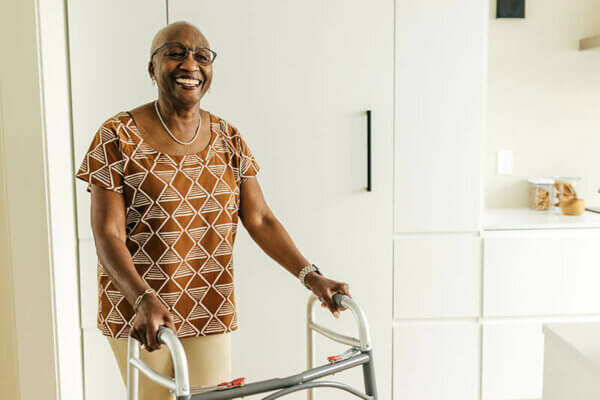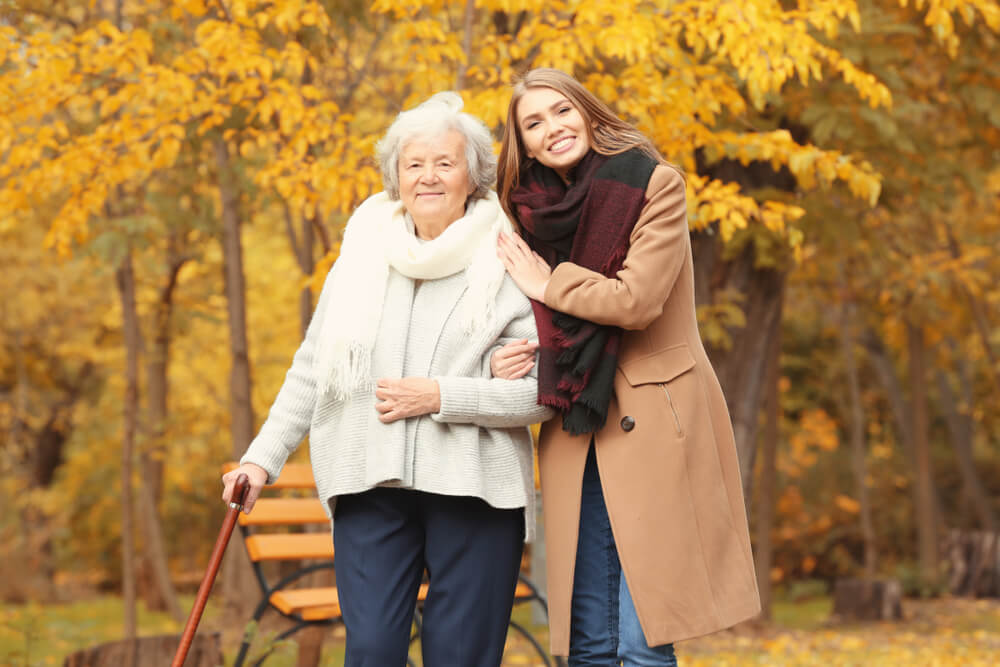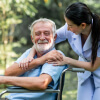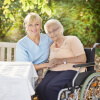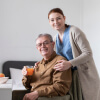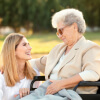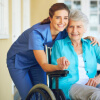Aging adults are high fall risks. Below are some tips to help prevent falls.
Falls become an increasing concern for many older adults, with risks escalating as we age. Fall-related injuries are the top cause of hospital visits for those 65 and over. But targeted fall risk screening along with practical safety measures tailored to the individual can help identify and reduce risks before debilitating falls occur.
For Houston Metro seniors wishing to remain independent at home, being proactive with fall risk assessments and prevention steps is key. By evaluating abilities through screens and optimizing home environments, health conditions and strength through therapy, many falls can be avoided.
Understanding Fall Risk Factors
One out of three seniors aged 65 or older will fall each year. The incidence increases to 50% for those over 80. Falls result in nearly 3 million emergency room visits annually and are the leading cause of injury-related death for those 65 and over.
Certain medical conditions and age-related physical changes predispose seniors to falling. Major risk factors include:
- Muscle weakness, especially in legs and core
- Balance and coordination difficulties
- Use of walking aids like canes or walkers
- Neurological diseases like Parkinson’s, dementia
- Arthritis impacting joints and restricting movement
- Impaired vision or hearing reducing environmental awareness
- Medications affecting cognition and balance
- Orthostatic hypotension with blood pressure drops
- Foot pain or ill-fitting shoes causing unsteady gait
- Osteoporosis resulting in fragile bones prone to breaking
Screening for risks combined with tailored, multi-faceted intervention can significantly reduce preventable falls.
Fall Risks: Screening and Assessments
Healthcare providers can conduct screens and assessments to identify seniors’ risk for falls, determine areas of deficit, and guide appropriate preventative steps. Common evaluations include:
Timed Up and Go Test – Measures time needed to rise from chair, walk 10 feet, turn and return. Over 10-12 seconds indicates high fall risk. Assesses mobility and balance.
30 Second Chair Stand – Counts stands from chair with arms folded across chest in 30 seconds testing leg strength and endurance. Fewer than 12 stands marks higher risk.
Multi-Directional Reach Test – Evaluates maximum distance one can reach forward, backward and to the sides while standing to test postural control. Less than 6 inch reach indicates challenges.
Berg Balance Scale – This 14-item scale assesses ability to maintain balance while doing tasks like standing, reaching, bending. Under 36 points indicates imminent fall risk.
Timed Floor Transfer – Times how long to lower to floor and back up testing coordination. Over 30 seconds can show mobility impairment.
These objective evaluations allow clinicians to assess capacities and tailor interventions to bolster specific abilities to prevent future falls.
8 Steps Seniors Can Take to Fall-Proof Their Homes
After identifying risks through screening, seniors and family members can take actions to reduce tripping and slipping hazards around the home:
Remove Clutter – Clear pathways inside and outside the home. Ensure adequate lighting without shadows or glare. Install handrails on both sides of stairways.
Install Grab Bars – Add grab bars inside showers or near toilets provide stability when moving between positions or sitting/standing.
Use Assistive Devices – Consult physical therapists about properly sized canes or walkers to aid stability during walking. Don’t walk unaided if unsteady.
Adapt Bathrooms – Install shower benches, elevated toilet seats, hand held shower heads and slip resistant mats/strips to make bathing safer.
Improve Lighting – Ensure rooms, hallways and entrances are well-lit. Install motion sensor night lights. Increase lamp wattage.
Store Items Within Reach – Keep regularly used kitchen, bathroom and clothing items within easy reach to avoid dangerous climbing or bending.
Wear Proper Footwear – Wear supportive, low-heeled shoes with non-slip soles. Avoid socks and slippery shoes. Replace worn treads.
Modify Flooring – Remove loose throw rugs. Repair carpeting. Install slip-resistant vinyl flooring in kitchens and bathrooms.
Consulting occupational therapists can help tailor home modifications based on physical ability assessments to make living spaces safer. Early home adaptations can significantly reduce risk.
Physical Therapy to Improve Strength and Balance
Beyond home adjustments, research shows physical therapy helps boost leg strength, balance, gait and coordination – all key to preventing tumbles. A customized PT regimen may include:
Lower Body Strengthening – Squats, leg extensions, calf raises, leg presses
Core Strengthening – Planks, crunches, lower back extensions
Balance Training – Tandem stance, heel-toe walking, head turns, single leg balance
Tai Chi – Gentle flowing movements to improve posture, balance reactions
Gait Training – Walking properly using canes, walkers, other assistive devices
Staircase Climbing – Step-overs, lateral walking, alternating feet
Physical therapists can tailor exercise programs based on each senior’s baseline abilities and challenges. Consistency with 2-3 PT sessions per week optimizes fall prevention.
Optimizing Health Conditions
Certain chronic health conditions increase fall risks. With physician guidance, managing these conditions can help lower fall rates:
Heart Disease – Controlling arrhythmias, orthostatic hypotension and medication side effects
Prior Strokes – Improving residual weakness, paralysis or coordination challenges
Parkinson’s Disease – Addressing medication side effects, using mobility aids, home proofing
Diabetes – Preventing foot numbness and ulcers through routine podiatry
Arthritis – Using anti-inflammatories, braces, PT to aid joint protection
Incontinence – Reducing urgent bathroom trips by addressing causes
Depression – Improving motivation for self-care and physical activity
Dementia – Providing added supervision and home safety adaptations
Optimizing certain high-risk health conditions reduces associated fall risks, keeping seniors steady.
Medication Adjustments to Prevent Falling
Various prescription and over-the-counter medications raise risks of dizziness, weakness and drowsiness – precursors to falls. With physician guidance, dosages and types can be adjusted:
Diuretics – Reducing or stopping if not medically necessary, as they increase urine production.
Blood Pressure Medications – Lowering dosages if drops in BP are extreme upon standing. Stopping unnecessary medications.
Tranquilizers – Eliminating or using lowest effective dose of anti-anxiety pills, sleep aids.
Antidepressants – Selecting types like SSRIs less likely to cause balance issues versus tricyclics.
Allergy/Sinus Pills – Choosing non-drowsy formulations.
Narcotic Pain Relievers – Using only if absolutely required at lowest effective dose. Avoiding long-acting versions.
Sedatives – Preventing mix ups with alcohol or other sedating medications.
Doctors can modify high-risk medications through careful review, helping prevent medication-induced falls.
When to Consider Higher Levels of Care
If a history of repeated falls persists despite interventions, or major traumatic injuries occur, moving to an assisted living community or memory care unit may become the safest option. Signs a higher level of care is needed include:
- Multiple falls weekly requiring help standing up
- Severe injuries like hip fractures or head trauma
- Inability to recall falls or circumstances clearly
- Unable to walk safely even with assistance
- Home safety steps fail to reduce fall recurrences
- Family cannot provide adequate hands-on support safely
- Dementia has progressed preventing proper oversight
For those experiencing frequent falls or injuries, 24/7 availability of staff in a supervised setting helps prevent future tumbles. However, many seniors can reduce risks through diligent prevention and maintain independent living.
The key pillars for reducing fall risks are early screening, medical oversight, home safety, therapy to build strength and balance, and medication management. While no single approach eliminates falls, individualized interventions personalized for each senior’s risks offer the best protection. With proactive steps, continued safe, healthy independence at home remains very achievable.
Contact us at 832-371-6600 for a free consultation to share the challenges you’re facing, and to learn how our personalized home care services can help you.
Home Matters Caregiving proudly serves the Houston Metro area providing care for seniors wherever they call home.
